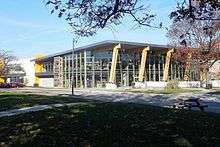Light in school buildings
Light in school buildings traditionally is from a combination of daylight and electric light to illuminate learning spaces (e.g. classrooms, labs, studios, etc.), hallways, cafeterias, offices and other interior areas. Light fixtures currently in use usually provide students and teachers with satisfactory visual performance, i.e., the ability to read a book, have lunch, or play basketball in a gymnasium. However, classroom lighting may also affect students' circadian systems, which may in turn affect test scores, attendance and behavior.[1]
Exposure to light, or lack thereof, plays a significant role in sleep cycles. All animals, including humans, have evolved circadian rhythms, which respond to the earth's 24-hour cycle. These rhythms include the sleep–wake cycle, hormone production, and core body temperature cycles. The timing of these patterns is set by the 24-hour light–dark cycle. In particular, short-wavelength "blue" light in the daylight spectrum has maximal effect on human circadian rhythms. Research has shown that when these patterns are disrupted, individuals are more susceptible to ailments such as breast cancer, obesity, sleep deprivation, mood disorders, and other health problems.[2][3][4][5]
Fluorescent lighting systems are the most prevalent sources of illumination in schools. These systems provide low cost, long life, high efficacy, good color, and low levels of noise and flicker. Lighting systems should be designed with respect to the requirements of the activity to be performed. For instance, lighting over a desk should be different than light required in cafeterias or hallways.[6] Current sustainable design guidelines for schools usually focus only on energy-conserving luminaires with consideration only for visual needs.

Studies regarding whether daylight improves student performance (e.g., higher test scores) are inconclusive. The Heschong-Mahone Group's studies between 1999 and 2003 reported early on[7] that daylight increased academic results by 20%, but because their model was used incorrectly, it was later demonstrated that there was no significant variance due to sunlight.[8][9]
A 2009 study showed that when students were not exposed to daylight in the early part of the day, sleep times were pushed later into the evening/night.[10][11]
Measuring light
Typical measurements of light have used a dosimeter. Dosimeters measure an individual's or an object's exposure to something in the environment, such as light dosimeters and ultraviolet dosimeters.
Application and effect
Ongoing research in the light and health field will have implications on school architecture and design because studies show that it is necessary to expose students to short-wavelength light during the early part of the day to maintain circadian entrainment. Implementing "circadian light" treatment could be in the form of windows, skylights, or blue indoor lighting fixtures or blue light therapy devices.[12][1] There is also evidence that exposing rooms to natural daylight will make a room feel larger and more comfortable.[13] However there are trade offs, as direct penetrating sunlight can have negative effects on productivity and comfort.[14]
See also
References
- National Research Council, "Lighting and Human Performance" Chapter 5 in Green Schools: Attributes for Health and Learning. Washington, D.C.: The National Academies Press, 2007.
- Stevens, RG 1987 Electric power use and breast cancer: a hypothesis Am. J. Epidemiol. 125 556
- Stevens, RG; Rea, MS 2001 Light in the built environment: potential role of circadian disruption in endocrine disruption and breast cancer Cancer Cause Control 12.3 279
- Schernhammer, ES; Laden, F; Speizer, FE; Willett, WC; Hunter, DJ; Kawachi, I; Colditz, GA 2001 Rotating night shifts and risk of breast cancer in women participating in the Nurses' Health Study J. Natl. Cancer Inst. 93 1563
- Schernhammer, ES; Laden, F; Speizer, FE; Willett, WC; Hunter, DJ; Kawachi, I; Fuchs, CS; Colditz, GA 2003 Night-shift work and risk of colorectal cancer in the Nurses' Health Study J. Natl. Cancer Inst. 95 825
- IEC Handbook
- Heschong-Mahone Group. 1999. Daylighting in Schools: An Investigation Into the Relationship Between Daylighting and Human Performance. Fair Oaks, CA: Heschong-Mahone Group.
- Boyce, P.R. 2004. Reviews of Technical Reports on Daylight and Productivity. Troy, NY: Lighting Research Center. Available at www.daylightdividends.org
- Heschong-Mahone Group. 2003. Windows and Classrooms: A Study of Student Performance and the Indoor Environment. P500-03-082-A-7. Fair Oaks, CA: Heschong-Mahone Group. pp. viii
- Figueiro, MG; Rea, MS. 2010. Lack of short-wavelength light during the school day delays dim light melatonin onset (DLMO) in middle school students. NeuroEndocrinology Letters, Vol. 31, No. 1 (in press).
- Wolfson, AR; Carskadon, MA. (1998). Sleep schedules and daytime functioning in adolescents. Chid. Dev. 69:875–887.
- http://www.lrc.rpi.edu/resources/newsroom/pr_story.asp?id=167
- Robbins, C.L. (1986). Daylighting Design and Analysis. New York, NY, USA: Van Nostrand Reinhold.
- Eric Brossy De Dios, T.R. (2010, February 1). Integrating Daylight into School Design From the Start. Light Moves American School and University.